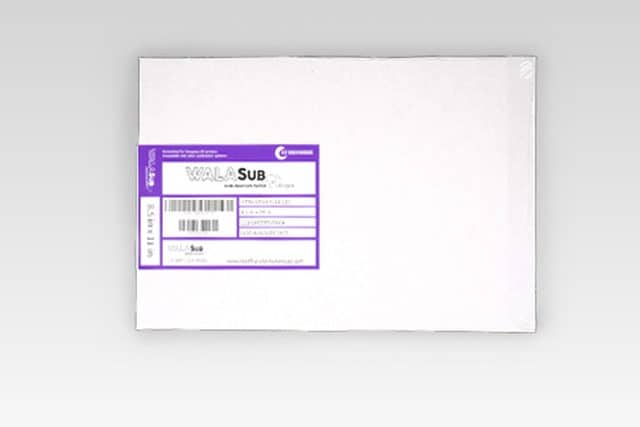Sublimation ink is an excellent ink to utilize because of its high-quality and waterproof properties. However, the question is can it be used on printable vinyl?

You shouldn’t use sublimation ink on plain printable vinyl. It uses high pressure and temperature at 350-400°F (176.67-204.44°C). Printable vinyl can melt at as low as 212°F (100°C). Likewise, it doesn’t have pores for the ink to settle.
Let’s explore these reasons, including possible alternatives to sublimation ink.
Why You Shouldn’t Use Sublimation Ink on Printable Vinyl
Let’s discuss the two materials first.
- Printable vinyl. Also known as polyvinyl chloride, it’s a type of permanent craft material that you can print on with an inkjet printer. It doesn’t require complex layering, which makes it perfect for smaller or more complex projects. Just like most vinyl products, you can use it to design tumblers, mugs, decals, even laptop covers.
- Sublimation ink. As the name suggests, it’s the type of ink used for sublimation printing. Only the ink is transferred to the fabric. This is in stark contrast with the heat transfer process, where the entire layer is printed on the material. The unique process makes the ink less likely to migrate, crack, or smudge.
Now that you know their basic properties, let’s get to the reasons why they don’t bode well together.
Sublimation Ink Requires High Temperature and Pressure
Polyvinyl chloride has a melting point of 212°F (100°C). It’s lower than the temperature required for sublimation printing, which is 350-400°F (176.67-204.44°C). In other words, printable vinyl may melt during sublimation printing.

For one, sublimation uses immense heat and pressure to turn the ink into gas without liquefying it. Heat (via a heat press) is also required to transfer the ink to the fabric. Even in home printing, sublimation will require pressure and heat. Thus, having to use a heat press at a very high temperature.
The immense heat also limits sublimation ink to certain fabrics, such as polyester. This means you can use sublimation ink on clothes, mouse pads, coasters, or mugs.
While sublimation ink may be used in various fabrics, it’s only suitable for light-colored ones. Add to that, it shouldn’t be applied on 100% cotton or other natural fibers. Just like vinyl, these materials can easily get damaged under high temperatures.
Printable Vinyl Doesn’t Have Pores To Capture the Sublimation Ink
Sublimation uses heat to open up the fabric’s pores so that the ink can settle into them. On the other hand, pressure closes the pores, thus ‘trapping’ the ink in the fabric.
This process prevents the ink from fading or washing off quickly. When you touch the surface, you’ll feel that the ink is embedded right into the fabric. Because of this, sublimation printing can help capture elaborate detail.

Printable vinyl, unfortunately, doesn’t have the pores to capture (and transfer) the sublimation ink. So while this makes vinyl waterproof, it’s a strong reason why sublimation ink can’t easily penetrate the fabric. Basically, the sublimation ink will sit on top of the printable vinyl until heat is applied then it will absorb into the vinyl but not transfer to the garment.
What You Should Do Instead
Sublimation ink and printable vinyl have their merits, but you can’t apply them to each other. You can use each of them separately, of course. Here are the three things you could do rather than ‘force’ the sublimation ink on your printable vinyl:
Use Sublimation/Copy Paper for Your Sublimation Ink
As mentioned, printable vinyl can melt under the high temperature and pressure required during sublimation.

As such, sublimation ink is best used on sublimation or copy paper.
When choosing a paper for your design project, make sure to consider the following:
- Ink capacity. The wetter or higher the ink limit, the heavier your paper should be. If not, it’ll be prone to damages such as warping or curling.
- Design. If your plan has a mix of light and heavy inks, you should use a paper weighing 110 gsm or more. Compared to lightweight pieces, they’re more resistant to curling or warping.
- Print speed. Fast printers require lighter paper, while slower printers demand heavier ones.
Use an Inkjet Printer for Your Printable Vinyl
Because printable vinyl melts at high temperatures, they work better with printers that don’t emit much heat. Such is the case with the inkjet printer, which can operate below vinyl’s melting point. The best example for this is the thermal inkjet printer, which has a temperature range of 59-95°F (15-35°C).
Likewise, you should consider the type of ink before you start printing. For example, aqueous ink won’t print well on printable vinyl, again due to its lack of pores and waterproof quality. When it comes to printable vinyl, it’s best to use solvent, eco-solvent, or latex ink.
Tip: Don’t use laser printers for printable vinyl, for it can emit temperatures at up to 400°F (204.44°C).
Try Heat Transfer Paper Instead
If your inkjet printer isn’t compatible with solvent, eco-solvent, or latex inks, you should consider using heat transfer paper instead. Since it’s paper, it bodes better on home printers. After all, they’re made to print on paper, not vinyl.
One of the best things about heat transfer paper is it’s relatively easy to use. After printing your design, all you need to do is heat press it on the material. It’s good if you have an actual heat press, but you can also use an iron for this. Heat transfer paper is also cheaper, which is perfect if you don’t have much money to spend on your printing project.
While heat transfer paper has a lot of benefits, it’s not as durable as vinyl printed materials. That said, the former should last 25-30 cycles of washing, especially if you follow the correct washing instructions.
Final Thoughts
Clearly, sublimation ink shouldn’t be used on printable vinyl. The printing process requires high heat and temperature that can melt the vinyl. Vinyl lacks pores that ‘trap’ the ink too.
If you have a sublimation printer, a sublimation or copy paper is the best material to use. If you have printable vinyl, then you should use an inkjet printer—with the correct ink, of course.
Be sure to check out some other nifty functional craft ideas through our other posts here on Craft-ILY as well as checking out some videos on DIY and How To’s over on YouTube. Look for “Crafting Unedited” or just click the name in blue to see!

Hello,
Hope you are fine. Great seeing the work you have put into your website. It is exceedingly informative and appealing.
“https://craft-ily.com/”
Would you mind considering me as a guest post contributor for your site?
I assure you it will be a helpful addition to your audience.
You can tell me about your preferred topic and I’ll get on with it right away. Or I can share with you some of the topics I have researched.
Would love to know about your interest in this regard.
Regards
Kate Suzen
Email me at support@craft-ily to discuss more 🙂